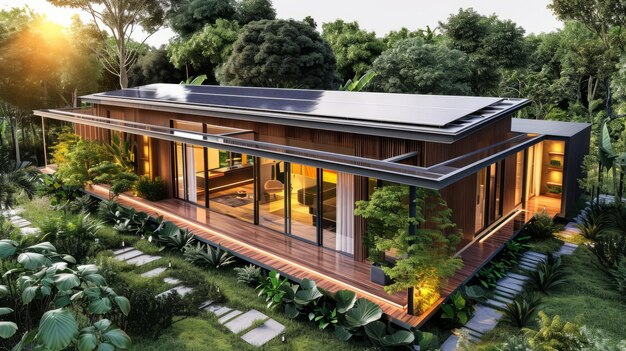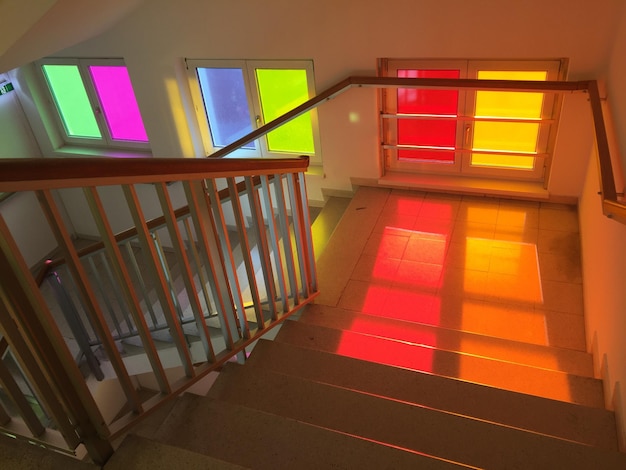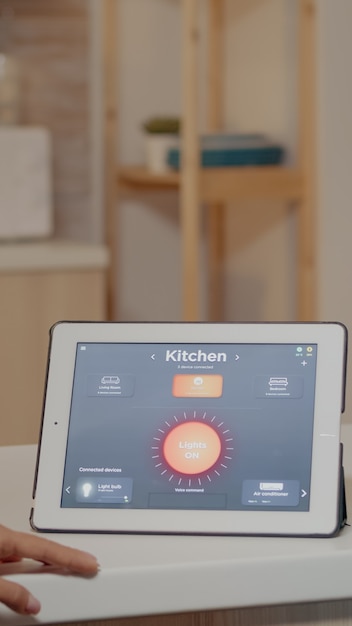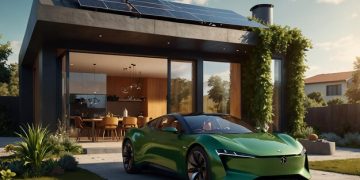Future-Proof Your Home: Energy-Efficient Upgrades Before 2026

Future-proofing your home with energy-efficient upgrades before 2026 involves implementing smart technologies, improving insulation, and switching to renewable energy sources like solar panels to reduce energy consumption and increase home value.
As we approach 2026, ensuring your home is energy-efficient is no longer just a trend, but a necessity. Investing in energy-efficient upgrades not only reduces your carbon footprint but also saves you money in the long run. Let’s explore three key upgrades to future-proof your home: 3 energy-efficient upgrades to make before 2026.
Understanding the Importance of Future-Proofing Your Home
Future-proofing your home goes beyond simple aesthetics; it’s about making it resilient and adaptable to future environmental and economic challenges. This includes enhancing energy efficiency, reducing reliance on fossil fuels, and improving overall sustainability.
Why Now is the Time to Act
With growing concerns about climate change and rising energy costs, the urgency to adopt energy-efficient measures has never been greater. Governmental incentives, technological advancements, and increased consumer awareness are converging to make this the perfect time to invest in your home’s future.
The Financial Benefits of Energy Efficiency
The upfront costs of energy-efficient upgrades can be daunting, but the long-term savings are significant. Reduced utility bills, increased property value, and potential tax credits can offset the initial investment, making your home more economically sustainable.

Consider these key benefits:
- Lower energy bills: Reduce your monthly expenses by decreasing energy consumption.
- Increased home value: Attract potential buyers with energy-efficient features.
- Government incentives: Take advantage of tax credits and rebates for green upgrades.
- Environmental responsibility: Minimize your carbon footprint and contribute to a sustainable future.
In conclusion, future-proofing your home is a proactive approach that addresses environmental concerns, economic benefits, and long-term sustainability. By acting now, you can enjoy a more comfortable, valuable, and eco-friendly living space.
Upgrade 1: Smart Home Technologies for Energy Management
Smart home technologies are revolutionizing how we manage energy consumption. These technologies provide real-time data, automation, and remote control capabilities to optimize energy usage.
Smart Thermostats
Smart thermostats learn your heating and cooling preferences and adjust automatically, reducing energy waste. They can also be controlled remotely via smartphone, allowing you to optimize energy usage even when you’re away from home.
Smart Lighting Systems
Smart lighting systems use LED bulbs and automated controls to minimize energy consumption. These systems can be programmed to turn off lights in unoccupied rooms, adjust brightness based on natural light levels, and be controlled remotely.

Key features include:
- Energy monitoring: Track your energy usage in real-time to identify areas for improvement.
- Remote control: Manage your home’s energy settings from anywhere using a smartphone or tablet.
- Automation: Set schedules and rules to automatically adjust energy consumption based on your lifestyle.
- Voice control: Integrate with voice assistants like Amazon Alexa or Google Assistant for hands-free control.
In short, integrating smart home technologies is a cost-effective approach to enhancing energy efficiency and reducing your carbon footprint. These technologies provide the tools you need to actively manage and optimize your home’s energy usage.
Upgrade 2: Enhancing Insulation for Optimal Energy Efficiency
Proper insulation is crucial for maintaining a comfortable indoor climate and reducing energy waste. Upgrading your insulation can significantly reduce heating and cooling costs.
Assessing Your Current Insulation
Start by assessing the current insulation levels in your attic, walls, and crawl spaces. Look for gaps, drafts, and signs of damage. An energy audit can provide a detailed assessment of your home’s insulation needs.
Types of Insulation Materials
There are various types of insulation materials available, each with its own R-value (resistance to heat flow). Common options include fiberglass, cellulose, spray foam, and rigid foam boards. Select the material that best suits your climate and budget.
Consider these tips for effective insulation:
- Seal air leaks: Caulk and weatherstrip around windows and doors to prevent drafts.
- Insulate the attic: Adding insulation to the attic is one of the most cost-effective energy upgrades.
- Wall insulation: Consider injecting insulation into existing walls to improve energy efficiency.
- Crawl space insulation: Insulating the crawl space can prevent moisture and reduce energy loss.
In conclusion, improving your home’s insulation is a fundamental step in future-proofing it for energy efficiency. Proper insulation reduces energy consumption, lowers utility bills, and enhances overall comfort.
Upgrade 3: Transitioning to Renewable Energy Sources
Switching to renewable energy sources, such as solar panels, can significantly reduce your reliance on fossil fuels and lower your carbon footprint. Solar energy provides a clean, sustainable source of power for your home.
The Benefits of Solar Panels
Solar panels convert sunlight into electricity, reducing your dependence on traditional power grids. This not only lowers your electricity bills but also provides a hedge against rising energy costs.
Understanding Solar Panel Systems
A typical solar panel system consists of solar panels, an inverter, and a mounting system. The inverter converts the direct current (DC) electricity generated by the panels into alternating current (AC) electricity that can be used to power your home.
Key considerations for solar panel installation:
- Roof orientation: South-facing roofs are ideal for maximizing solar energy production.
- Panel efficiency: Choose high-efficiency panels to generate more power in a smaller area.
- Net metering: Take advantage of net metering programs that allow you to sell excess electricity back to the grid.
- Maintenance: Regularly clean your solar panels to ensure optimal performance.
In summary, transitioning to renewable energy sources is a significant step towards future-proofing your home. Solar panels offer a sustainable, cost-effective solution for reducing your carbon footprint and enhancing energy independence.
Government Incentives and Rebates for Energy-Efficient Upgrades
Many government programs offer incentives and rebates to encourage homeowners to invest in energy-efficient upgrades. These incentives can significantly reduce the upfront costs of these projects.
Federal Tax Credits
The federal government offers tax credits for various energy-efficient upgrades, including solar panels, energy-efficient windows, and insulation. These credits can help offset a significant portion of the project costs.
State and Local Rebates
Many states and local municipalities offer rebates for energy-efficient appliances, insulation, and renewable energy systems. Check your local government’s website for available programs.
Tips for navigating incentives and rebates:
- Research available programs: Start by researching federal, state, and local incentives in your area.
- Check eligibility requirements: Ensure that you meet the eligibility requirements for each program.
- Keep detailed records: Maintain detailed records of all expenses for tax reporting purposes.
- Apply early: Apply for rebates early, as funding is often limited and available on a first-come, first-served basis.
In conclusion, taking advantage of government incentives and rebates can make energy-efficient upgrades more affordable and accessible. By researching and applying for these programs, you can reduce the financial burden of future-proofing your home.
Maintenance and Long-Term Care for Energy-Efficient Systems
Proper maintenance is essential to ensure the long-term performance and efficiency of energy-efficient systems. Regular maintenance can prevent costly repairs and extend the lifespan of these investments.
Maintaining Smart Home Devices
Regularly update the software on your smart home devices to ensure they are functioning optimally. Clean sensors and cameras to maintain accurate data collection.
Insulation Inspection
Inspect your insulation annually for signs of damage or moisture. Address any issues promptly to prevent energy loss and structural damage.
Best practices for long-term care:
- Schedule regular maintenance: Set up a schedule for routine maintenance tasks, such as cleaning solar panels and inspecting insulation.
- Monitor energy usage: Track your energy usage to identify any anomalies or inefficiencies in your systems.
- Address issues promptly: Address any maintenance issues promptly to prevent them from escalating into more significant problems.
- Keep records: Maintain detailed records of all maintenance activities and expenses.
In short, long-term care and maintenance are critical for maximizing the benefits of energy-efficient systems. Regular maintenance ensures optimal performance, reduces energy waste, and extends the lifespan of these investments.
| Key Point | Brief Description |
|---|---|
| 💡 Smart Home Tech | Optimize energy use with smart thermostats and lighting. |
| 🛡️ Insulation | Improve insulation to reduce heating and cooling costs. |
| ☀️ Renewable Energy | Transition to solar panels for sustainable energy. |
| 💰 Incentives | Utilize government incentives to lower upgrade costs. |
What are the key benefits of future-proofing my home?
Future-proofing your home offers numerous benefits, including reduced energy costs, increased property value, and improved environmental sustainability. Additionally, it enhances comfort and resilience against future challenges.
How do smart home technologies improve energy efficiency?
Smart home technologies, such as smart thermostats and lighting systems, automate energy management, optimize usage based on your preferences, and provide real-time monitoring to identify areas for improvement, thereby reducing energy waste.
What types of insulation materials are most effective?
Effective insulation materials include fiberglass, cellulose, spray foam, and rigid foam boards. The best choice depends on your climate, budget, and specific needs for different areas of your home, like attics, walls, and crawl spaces.
How can I take advantage of government incentives for energy upgrades?
To leverage government incentives, research federal, state, and local programs, check eligibility requirements, keep detailed records of expenses, and apply early, as funding is often limited and available on a first-come, first-served basis.
What maintenance is required for energy-efficient systems?
Maintenance for energy-efficient systems includes regularly updating software for smart devices, inspecting insulation annually for damage, cleaning solar panels to ensure optimal performance, and monitoring energy usage to identify inefficiencies.
Conclusion
Future-proofing your home with energy-efficient upgrades is a proactive and beneficial approach to enhancing comfort, reducing costs, and promoting sustainability. By implementing smart home technologies, improving insulation, and transitioning to renewable energy sources, you can create a resilient and environmentally responsible living space. As we approach 2026, these upgrades will not only improve your quality of life but also contribute to a more sustainable future for all.





